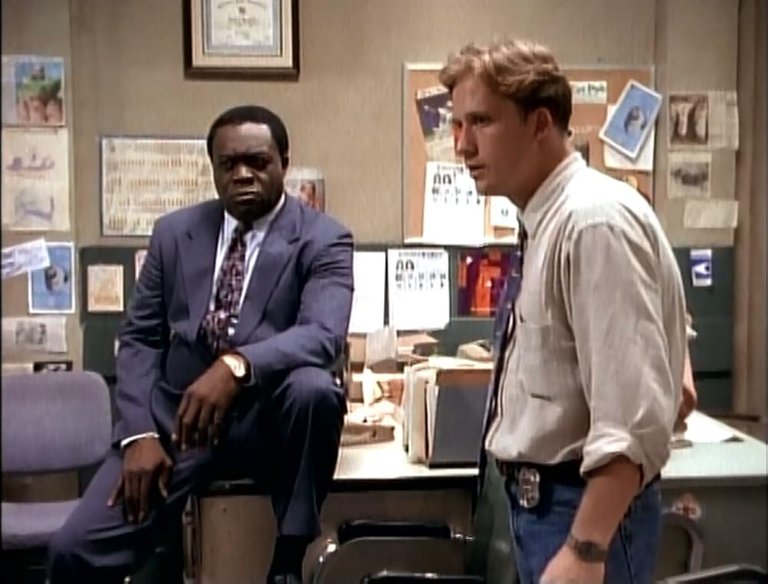Television Review: Fire, Part 2 (Homicide: Life on the Street, S4X02, 1995)

Fire, Part 2 (S04E02)
Airdate: 27 October 1995
Written by: Jack Behr
Directed by: Nick Gomez
Running Time: 48 minutes
The second instalment of Homicide: Life on the Street’s fourth season premiere, Fire, Part 2, exemplifies the series’ commitment to unflinching realism and narrative cohesion. This episode deftly resolves the arson-murder mystery introduced in Fire, Part 1 while integrating Detective Mike Kellerman (Reed Diamond) into the Homicide unit without compromising the show’s signature grittiness. Retaining the handheld camera work, morally ambiguous characters, and procedural authenticity that defined its first three seasons, the episode avoids contrived melodrama, instead grounding Kellerman’s introduction in the bleak pragmatism of Baltimore’s crime-riddled streets. The result is a taut, intelligently structured hour that balances plot resolution with character development, reaffirming Homicide’s status as a pioneer of police procedural realism.
The plot intensifies as Lieutenant Al Giardello (Yaphet Kotto) faces mounting pressure to solve the “Red Ball” case involving two arson-related murders. With departmental promises of additional manpower contingent on closing the case, the discovery of a second victim—15-year-old Bonnie Nash, a former student of chemistry teacher Gavin Robb (Adam Trese)—sharpens the urgency. Detectives Pembleton (Andre Braugher) and Bayliss (Kyle Secor) methodically trace clues, including a blue van and stolen toilet paper used as “trailers” to spread flames, but hit a wall during Robb’s interrogation. Enter Kellerman, whose unorthodox tactics—feigning resignation before springing a trap with the question, “Why did you kill the dog?”—exploit Robb’s affection for animals, prompting an inadvertent confession.
Giardello, impressed by Kellerman’s ruthlessness, offers him a permanent transfer to Homicide. Kellerman’s initial reluctance, rooted in self-doubt, is poignantly challenged during a visit to his father (played by Pat McNamara), a distillery worker resigned to life’s limitations. This exchange—a masterclass in understated characterisation—culminates in Kellerman’s acceptance, symbolising his transition from arson investigator to a detective willing to navigate moral grey areas.
Fire, Part 2 excels in fleshing out Kellerman’s duality: streetwise yet introspective, cocky yet vulnerable. His friction with Pembleton and Bayliss—initially dismissive of his “Arson Unit” credentials—evolves into grudging respect as he outmanoeuvres Robb, a villain whose veneer of civility masks chilling calculation. The interrogation scene subverts the “good cop/bad cop” trope, with Kellerman sarcastically dismissing the dichotomy before deploying psychological manipulation. By feigning incompetence (“I’m the dumb cop”), he lulls Robb into complacency, revealing a strategic cunning that rivals Pembleton’s intellectual rigour. This sequence, among the series’ finest, underscores Homicide’s knack for elevating procedural tropes into riveting character drama.
Robb’s portrayal as an “Affably Evil” antagonist—a chemistry teacher who aids the homeless yet murders to conceal a student-teacher affair—adds layers of moral ambiguity. His downfall, engineered through Kellerman’s exploitation of empathy for a non-existent dog, critiques the fragility of performative virtue.
While the episode’s core thrives, subplots like Detective Howard (Melissa Leo) and Munch’s (Richard Belzer) rivalry over a sergeant’s exam feel underdeveloped. Howard’s promotion arc—a recurring thread in Season 4—serves primarily to highlight workplace politics, but its resolution (Munch’s no-show) lacks emotional heft. Similarly, Pembleton’s anxiety about parenthood, though thematically resonant, is relegated to fleeting rooftop conversations. Yet these elements never overshadow the main narrative, instead reinforcing the ensemble’s lived-in dynamics.
Fire, Part 2 remains a standout episode, seamlessly integrating a new protagonist into Homicide’s bleak universe while delivering a psychologically nuanced mystery. Kellerman’s introduction—marked by moral complexity and tactical brilliance—exemplifies the series’ refusal to sanitise policing or humanise its villains. Though minor subplots dilute focus, the episode’s strengths—sharp dialogue, layered performances, and a refusal to romanticise justice—cement its place in Homicide’s legacy as a benchmark for televised realism. As Giardello might say, it’s a “red-to-black” triumph.
RATING: 7/10 (+++)
Blog in Croatian https://draxblog.com
Blog in English https://draxreview.wordpress.com/
InLeo blog https://inleo.io/@drax.leo
Hiveonboard: https://hiveonboard.com?ref=drax
Rising Star game: https://www.risingstargame.com?referrer=drax
1Inch: https://1inch.exchange/#/r/0x83823d8CCB74F828148258BB4457642124b1328e
BTC donations: 1EWxiMiP6iiG9rger3NuUSd6HByaxQWafG
ETH donations: 0xB305F144323b99e6f8b1d66f5D7DE78B498C32A7
BCH donations: qpvxw0jax79lhmvlgcldkzpqanf03r9cjv8y6gtmk9
Posted Using INLEO